The Future of Flexible Electronics
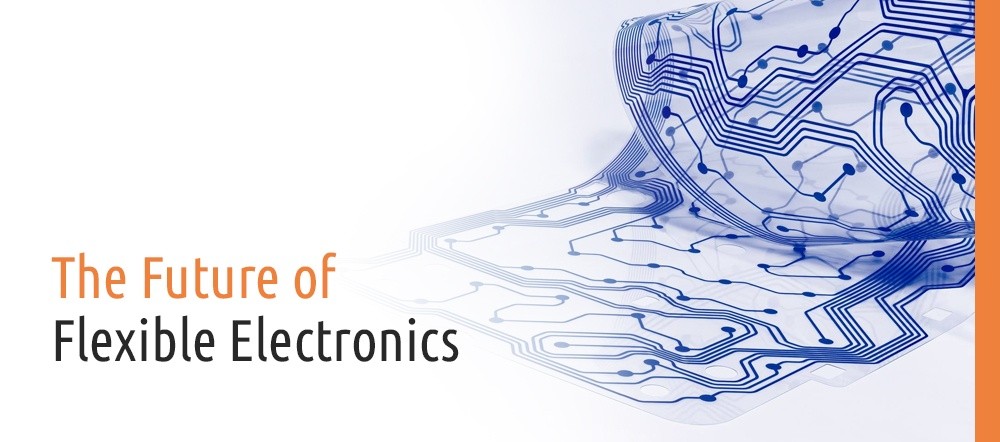
Flexible electronics are game-changers in the world of technology. There are many advantages of flexible electronics., and since they’re so lightweight and malleable, they change the capabilities of products and equipment in a variety of industries. To understand the potential of flexible electronics, you’ll first need to know more about what flexible electronics are, why they’re used, and who uses them. Then, you’ll be ready to understand the current trends in flex circuit technology, along with what the future holds for the technology.
What Are Flexible Electronics?
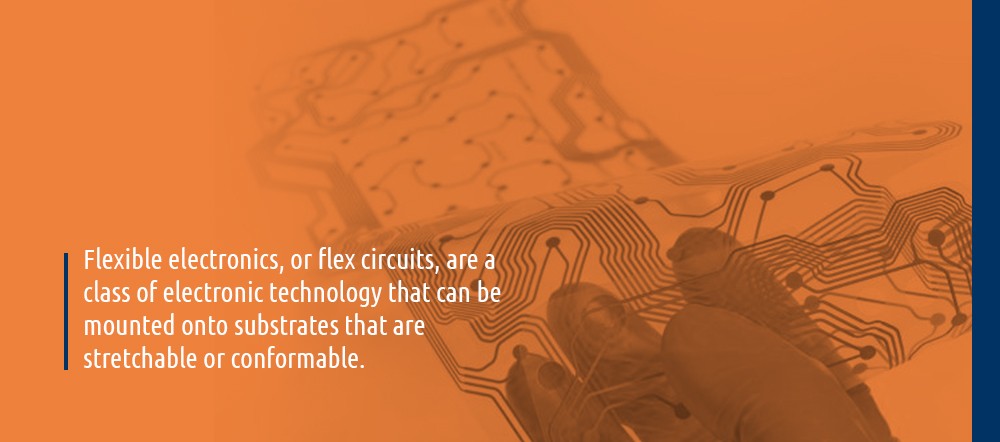
Flexible electronics, or flex circuits, are a class of electronic technology that can be mounted onto substrates that are stretchable or conformable. These flex circuits define themselves by how they can be bent, twisted, stretched or conformed into unique shapes. The substrates are mainly plastic, but there are versions made out of flex glass, metal foil and paper. A special kind of conductive polyester film is typically used in the construction process.
The history of flexible electronics began at the beginning of the 20th century. In 1903, Dr. Ken Gileo placed a patent on what would now be recognized as a flex circuit. This patent described an electronic device that had flat metal conductors installed on paraffin coated paper. In recent years, products that use flexible electronics are becoming more commonplace, and many companies are looking to take advantage of flex circuits.
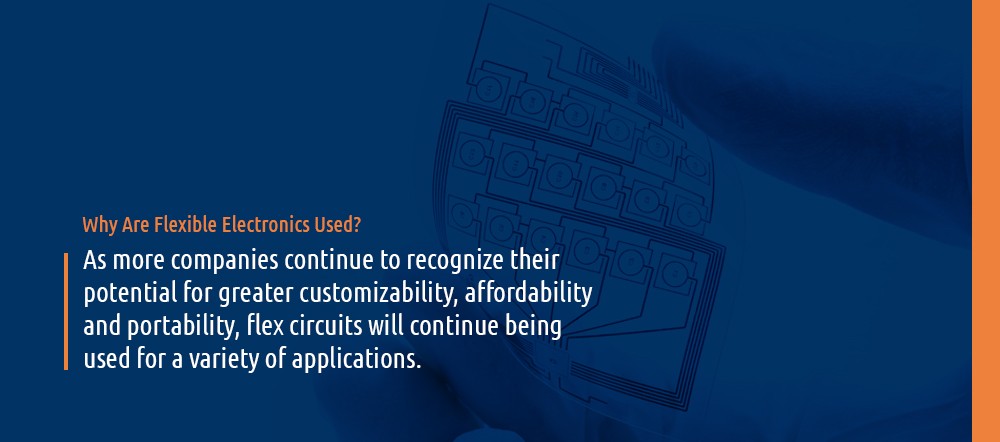
Why Are Flexible Electronics Used?
Flexible electronics are growing in popularity due to the many benefits they provide users. As more companies continue to recognize their potential for greater customizability, affordability and portability, flex circuits will continue being used for a variety of applications. So many industries and professionals are implementing flexible electronics into their devices and products because they are:
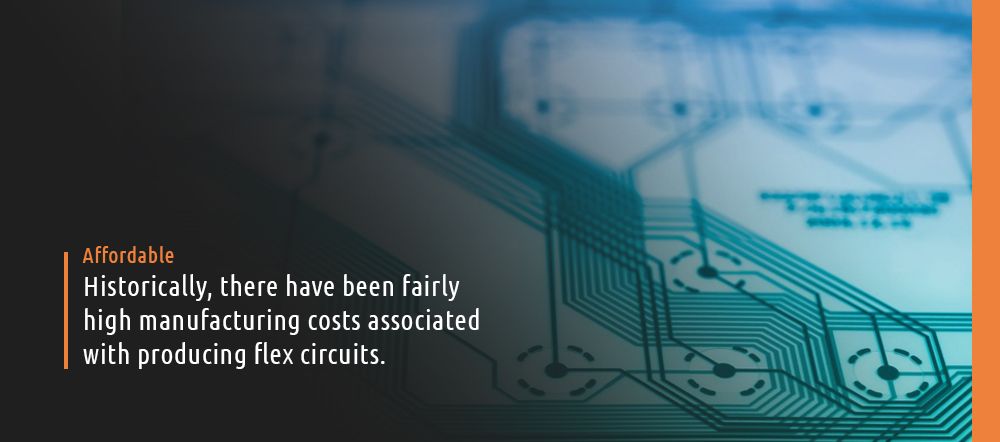
1. Affordable
Historically, there have been fairly high manufacturing costs associated with producing flex circuits. However, the continued growth of these products has led to innovations that continue to lower costs and provide a low-cost alternative to more traditional electronics.
For example, researchers at North Carolina State University have discovered new flexible electronics manufacturing practices that reduce costs while improving efficiency. Besides researchers from universities, companies are attempting to make flex circuits consistently less expensive than their traditional counterparts.
2. Flexible
While flexible electronics research and development are still young, its ability to work with cheaper substrates already gives it an advantage over more traditional electronics that rely on expensive substrates like glass.
Professors from Penn State see immense potential for inexpensive, flexible electronic manufacturing. As the field develops, people will be able to print out flexible electronic parts on a cheaper substrate like plastic film. Instead of having to use expensive glass substrates, companies will use more affordable, flexible substrates like plastic while maintaining device functionalities.
3. Customizable
Flex circuits give companies the ability to provide more personalized experiences to consumers. For example, products like smart bands that rely on flexible electronics in their displays. In a smart band, you have a mix of systems, sensors and displays that track and communicate data to users. Oftentimes, these devices give people the ability to keep tabs on their health and share information with their friends. Flex circuits make it possible for these complex devices to fit on your wrist.
Other than just providing personalized data to consumers, flex circuits can be adjusted to fit the exact needs of a single application. Since their flexible substrates can be conformed to a specialized shape, people won’t have to worry about a flex circuit not working for a uniquely shaped product or device. Additionally, there are few different substrates that are appropriate for flex circuits, letting companies find the one that’s perfect for their needs. Flexible electronics are continuously opening customizable possibilities for consumer electronics.
4. Innovative
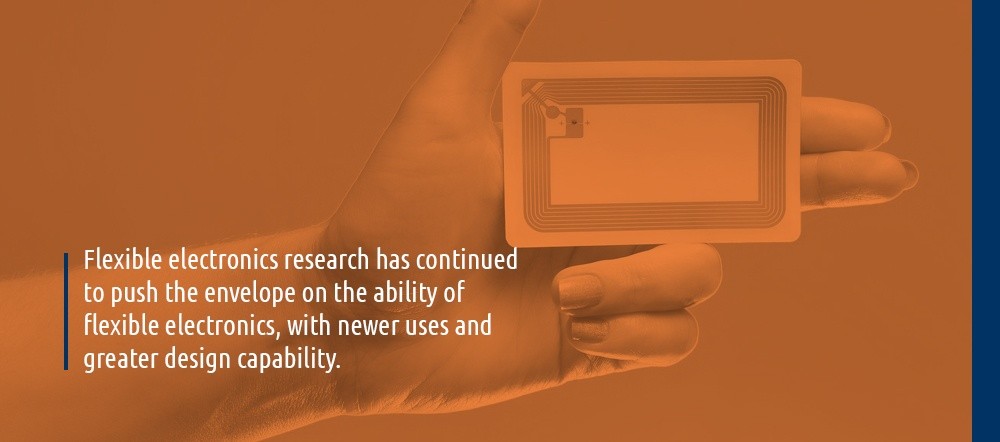
Flexible electronics research has continued to push the envelope on the ability of flexible electronics, with newer uses and greater design capability. One of the biggest innovations of flexible electronics has been the improvement of flexible sensors and displays. For example, you might have seen a flexible display that can go from being small and non-intrusive to fold out into the size of a television thanks to the bending radius of flexible technology.
Due to their flexibility, companies that use flex circuits particularly enjoy the greater design options they provide users. With this tech, you can have a smartphone snapped around your wrist while driving a car that has monitors implemented in them that rely on flexible electronics. The customizability of flex circuits almost guarantees that companies will continue to use them for surprising new purposes and to improve old devices.
5. Portable
Portability is one of the main benefits of flexible electronics. Many traditional electronics are not very transportable, as they will usually come with glass-based displays made out of components that are more susceptible to break. With flex circuits, you avoid this problem due to the organic thin-film transistors that help products be significantly thinner and lighter. As a result of these changes, products that utilize flexible electronics often have the durability and size needed for easy transport.
Who Uses Flexible Electronics?
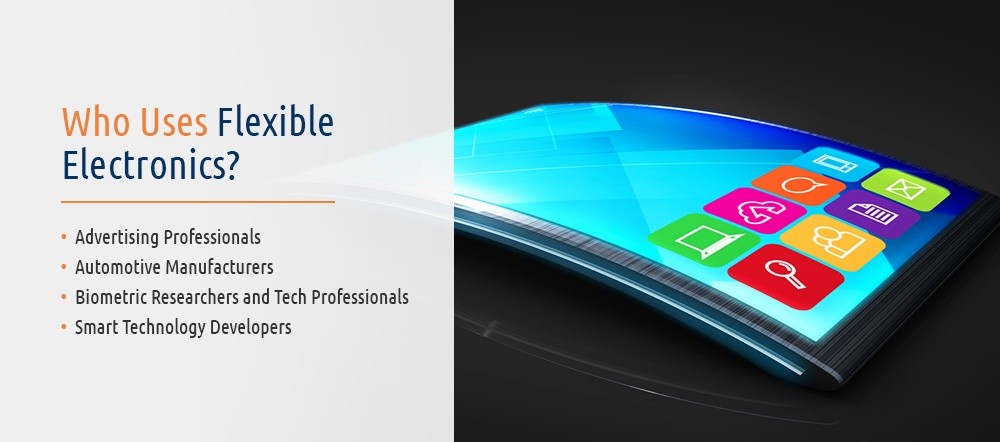
Professionals and researchers in a wide variety of industries are starting to rely on flexible electronics. To give you a clear understanding of how flexible circuits are used, take a look at the different types of professionals who regularly use flexible electronics to improve the equipment and products they offer:
Advertising Professionals
Flexible electronics have provided a lot of value to the marketing world, particularly when it comes to digital signage. Companies regularly rely on digital signage to deliver messages that can be quickly adjusted when needed. The ability to play video or display crisp static images makes digital signs some of the best pieces of technology to get the attention of consumers.
Flexible electronics add to digital signs by providing flexible displays that provide the same image quality while coming in more complex shapes and being incredibly durable. Instead of relying on heavy glass for their display screens, flexible displays are often made with a special plastic that allows for greater creativity and forms. Due to their durability and ability to conform to particular applications, flexible displays have been placed on the backs of furniture, such as chairs or benches out in public.
Automotive Manufacturers
The automotive industry has been quick to start incorporating flexible electronics into their cars, with many new advancements coming. For example, a recent study predicts that 34 million cars will have biometrics installed that assist with personalization and identification by 2025. With this tech, a flexible sensor array in the steering wheel could recognize who is driving the vehicle, adjusting the music, the seat height or a variety of other factors accordingly.
Other than adding biometric capabilities to vehicles, those in the automotive industry have started to use flexible displays. Flex circuits allow a vehicle’s displays to better match the shape of the car and provide more ergonomic features for customers. In the event of a crash, flexible displays can be safer than their glass-based alternatives, as they can be made with materials that are shatterproof.
Biometric Researchers and Tech Professionals
Another primary area where flexible electronics have flourished is in the field of biometrics. As biometric technology often relies on fingerprint scanning to authenticate a user, flexible sensor arrays are invaluable to Biometric researchers and professionals. These arrays help scan fingerprints, with some tech even capable of imaging veins, adding an extra layer of protection over just the fingerprint. These sensor arrays have to be thin, durable and light, making flexible electronics a natural choice.
You can find flexible sensor arrays in products like smartphones and smartwatches — along with other kinds of wearable tech. Incorporated into the smartphone, flex circuits provide users greater security. Due to their flexibility, they can also be placed in areas of the phone that are most convenient to users without disrupting the phone’s design. For wearables, flex circuits are especially useful since they can conform to a wrist shape and even be integrated into the watch strap.
Smart Technology Developers
Smart devices and appliances are storming the market. From smart fridges and speakers to smart thermostats and watches, the market for this kind of tech is huge. Due to their glass-based displays, traditional smart devices have to come in a more rigid form to protect against shattering.
To improve the quality of these devices, many companies are turning to flexible electronics. Flexible displays allow for devices to come in unique shapes, giving manufacturers more creativity. Since a designer can create a piece of smart technology that meets their vision exactly, smart technology products that use flex circuits often stand apart from the competition.
Five Current Trends in Flexible Electronics

Along with the many industries utilizing flexible electronics, you should know about a few different trends in the flexible electronics market that promise to revolutionize the technology — these include:
1. Healthcare and Wellness
The healthcare industry is taking advantage of flexible electronics. Every day consumers already have embraced wearable technology, with many loving the health information that these devices provide. By wearing smart devices, users learn more about their heartbeat, steps for the day, sleep quality, exercise tracking and other wellness-based information. Besides wearable tech available to consumers, more specialized medical wearables are continuing to grow, giving crucial information to medical professionals and helping them provide superior care.
In addition to wearables, the healthcare industry is also beginning to utilize flex circuits due to their flexibility. For example, stretchable sensors allow users to help patients be more comfortable while also giving professionals plenty of data. Gas sensors have also made impressive strides with flexible electronics. With devices that use flex circuits and incorporate carbon nanotubes and graphene, professionals can receive plenty of information about biomarkers found in a patient’s breath.
2. Structural Electronics
Companies are beginning to recognize the potential for structural electronics. In contrast to traditional electronics that utilize a printed circuit board with a protective shell placed around it, flexible electronics give designers the opportunity to place “smart skins” around their electronic devices and products. Essentially, structural electronics come about by printing out functional electronic circuitries that fit on irregular-shaped architectures. After printing, these structural electronics are electronic circuits and components that replace “dumb structures” with structures that are load-bearing and protective.
Many in the automotive industry are attempting to utilize structural electronics for their vehicles. When structural electronics are implemented inside the undercarriage and body of the car, a vehicle’s exterior starts to take on the appearance of a human nervous system. The exterior of a vehicle becomes sensitive to damage and touch, opening s up a whole range of safety features.
3. In-Mold Electronics
In-Mold Electronics are a type of structural electronics that are three-dimensional. They give users the advantages of quick turnaround times, lightweight parts, fewer components needed to integrate and flexible design opportunities. As this form of flexible electronics technology becomes more reliable and scales up, in-mold electronics are only going to continue to grow.
4. Hybrid Electronics
Hybrid electronics combine traditionally manufactured electronics with flexible electronics. This trend to combine the old and new gives companies the best of both worlds. As of now, conventional electronics tend to offer integrated circuits that have higher electrical performance and an easier production process due to infrastructure already being in place. The newer flex circuits clearly beat out the traditional electronics with their conformability, thinness and lightweight design.
Hybrid electronics are a top choice for many, as they combine the best of both worlds. Users receive electronics that have the power of traditional circuits and other components with the greater malleability and design freedom of flexible electronics.
5. Conductive Inks
Flexible electronics open up a wide market for conductive inks that can be used in conjunction with integrated circuits (IC) and better 5G coverage. Effectively, conductive inks allow users to draw functional circuits onto a variety of substrates like textiles or paper.
Since the plating of traditional integrated circuits can make it hard for the IC package to pick up reliable 5G coverage from all sides of it, conductive inks are an attractive option. Companies are going to continue to invest in conductive inks to provide better coverage, while also making the production process faster and less expensive.
What The Future Holds
Besides knowing about the current trends in flexible electronics, you should know what’s coming in the future, so you can plan accordingly. Several industries are already expanding their uses of flexible electronics, and many other industries will soon recognize their potential. Take a look at a few industries that are likely to receive major benefits from integrating flexible electronics into a variety of products and equipment:
Industrial
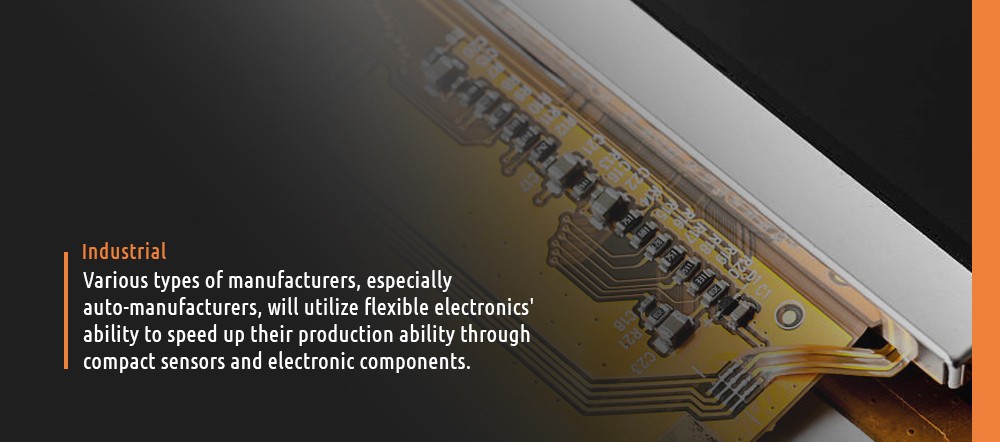
The industrial section of the economy will gain a lot of value from flexible electronics. Various types of manufacturers, especially auto-manufacturers, will utilize flexible electronics’ ability to speed up their production ability through compact sensors and electronic components. Since industrial devices need many interconnections to function properly, flexible circuits are welcome technology. They give factories the ability to fit all the connections into a compact form, providing new capabilities to equipment and making items less bulky.
Medical
The medical world is seeing huge returns on flexible electronics, and many innovative devices will be coming to consumers in the near future. Some of the most revolutionary types of devices powered by flex circuits are:
- Electronic skin: With electronic skin, patients will be able to wear a plastic film that has organic circuits installed in it. The skin has the ability to monitor a wearer’s pulse, the oxygen concentration in their blood and their temperature. By using electronic skin, users can be more aware of their potential health problems and deliver priceless data to their health professionals.
- UV radiation tracking patch: With a UV radiation tracking patch, users will be able to track how much harmful UV light they are receiving. Potentially, the patch could deliver the information straight to your smartphone, letting you know if you need to be extra vigilant about looking for melanoma and other potentially damaging effects of UV radiation.
- Flex circuits in contact lenses: One fascinating possibility for the future of flexible electronics is contact lenses that have electrically-conducting polymers placed onto them. With these contact lenses, a user could send an image from a TV or computer screen straight into their contact lenses. Sensors built into the lens could theoretically also track a user’s glucose level, and then show said level to the user by projecting information into the lens.
Energy
One of the most promising innovations in the energy sector is printable solar panels. Flexible electronics, in the form of organic photovoltaics (OPVs), are opening up possibilities for solar energy. Instead of having to place solar panels on a roof, an OPV could print solar energy technology into your curtain’s fabric or have it laminated on your window panes. Consumers may even see the technology go into solar power-generating clothing, which could help recharge phone and laptop batteries.
OPVs are thin and flexible, with their cells placed on a flexible substrate. The technology absorbs sunlight and then transfers that energy to devices. Not only do these OPVs promise to be easier to place in your home and fit unique needs, but they may also be much cheaper than traditional solar panels. The decrease in cost largely comes from OPVs using a polymer-based layer for their semiconductor, while most solar panels on the market use more expensive semiconducting materials like silicon.
Researchers and industry professionals are working on ways to make OPVs more available and integrate them into different types of products. In the future, expect to see more of these OPVs.
Electronics
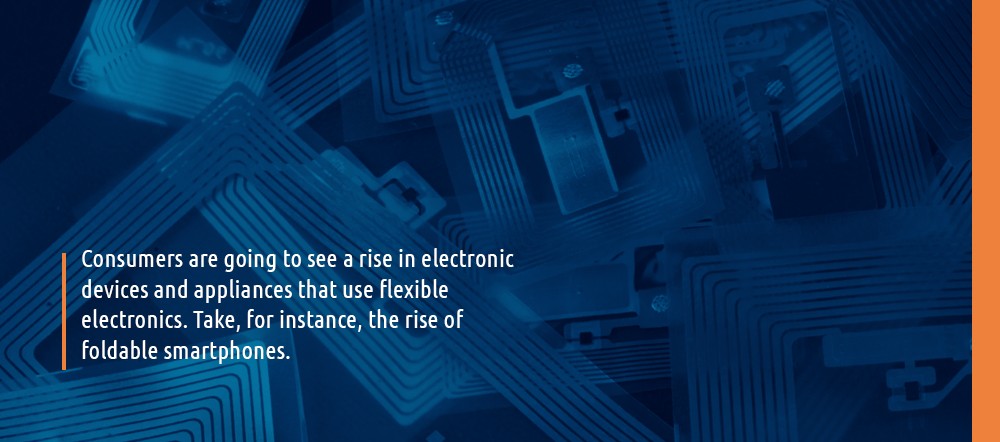
Consumers are going to see a rise in electronic devices and appliances that use flexible electronics. Take, for instance, the rise of foldable smartphones. While some of these new phones struggle with durability, flex circuits will help change that as the technology progresses. Expect to see more durable foldable smartphones, as organic light-emitting polymers (OLEDs) improve and become more popular.
Other than smartphones, don’t be surprised if you start to see TVs that can be rolled up in people’s living rooms. TVs made with OLEDs will become more widespread, giving consumers a thinner and more flexible alternative to traditional LCDs. Expect these TVs to be able to fold or roll up, providing users the most non-intrusive screens ever.
Wearable Devices
Though wearable technology is already embracing flexible electronics, its future is even brighter. Today, wearable tech is hampered by large, heavy batteries that take up a significant amount of space in wearable devices. These batteries can make the wearable tech larger than it needs to be and too cumbersome for some users to use.
Flexible batteries can help to shrink the size of smartwatches and other wearable devices. They are perfect for wearable tech, as they can be integrated into the bands. As more development goes into flexible batteries, expect to see them paired with wearable devices, like smartwatches.
Stay Updated on the Latest Manufacturing Trends
Flex circuits have a bright future and are sure to benefit companies and consumers alike. Global Electronic Services has no doubt that flexible electronics is only going to continue to improve and open doors for those who begin utilizing it.
As a leader in the electronic repair industry, Global Electronic Services is always looking for the newest developments in electronics. To stay up to date on the latest manufacturing trends, take a second to subscribe to our blog. If you happen to have an electronic repair job that needs completing, feel free to contact us and get a free quote.
